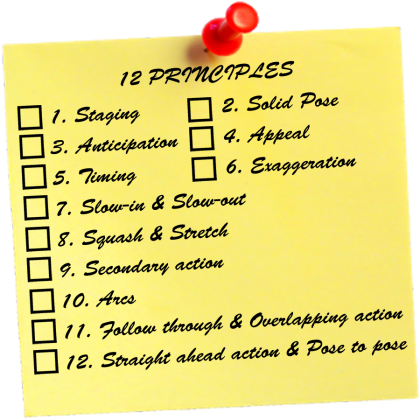Hi everybody,
The first thing you learn when you study animation is the 12 principles and nowaday they still are the fundamental rules of the animators.
But just knowing them is useless (except perhaps if you want to be the smart ass of the party) if you do not understand how to apply them .
I have been analyzing them and here I wrote down how and when to use them during the animation process:
ROUGH BLOCKING
During your Rough Blocking you'll have to mark the main poses or Golden Poses so everybody understand your shot at first sight.
1. STAGING : It is quite similar to theater or a movie set. When creating the Staging, you'll have be sure to direct the attention of the audience and show clearly what is the most important thing in your scene throught your composition and you will have to check that you have used all the stage to your advantage.
BLOCKING
In that stage, you'll have to mark all the key poses so your director will have all the information of timing and poses that want to transmit.
2. SOLID POSE : For me that principle means taking into account the biomechanics and anatomy of character. You'll have to check, when building your poses, that you are marking the angles of the torso and shoulders depending on the weight, balance and fulcrums.
3. ANTICIPATION : It is used to prepare the audience for an action and make it look more realistic. Check that it every action this pretty "announced" not to confuse the viewer.
4. APPEAL : It corresponds to what is known as the charisma of an actor. Check that your character attracts the eye of the audience and entertains through the details and the harmony of the pose.
5. TIMING : It refers to the number of frames used for a given action, which means the speed of an action in a movie. Check that you have been clear, credible and entertaining.
6. EXAGGERATION : It is an effect used especially in animation, because if you just copy reality it may look perfectly static or boring. Push your poses, actions and timing to support your concepts.
BLOCKING ADVANCED
Here, we are looking for the energy of your shot and you will have to check if the physical properties works through your timing and spacing.
7. SLOW-IN & SLOW-OUT : The movements of human body and most of the objects needs time to accelerate and decelerate. Work your spacing to avoid mechanical movements and interpolations and define the rythm of your actions.
8. SQUASH & STRETCH : That means compression (Squash) and stretching (Stretch) of an animated object without changing its apparent volume. Once you've worked the spacing, look for the moment when masses are stretched and compressed to give a sense of weight and flexibility to the objects.
9. SECONDARY ACTION : It means adding secondary actions to the main action to support it and bring more life to your shot. Search for small auxiliary movements designed to enrich the main action without distracting.
SPLINNING
At this stage, you'll have to check if the body dynamics are working and if everything is fluid and readable for your director.
10. ARCS : Most of the natural actions tend to follow a path of action throught an arc shape, that's why an animation should stick to this principle by creating those "arcs" to bring the feeling of realism. Open and refine your arcs to make your movements readable and give them more fluidity.
POLISHING
Finally, the polishing allows you to refine your shot and add texture.
11. FOLLOW THROUGH & OVERLAPPING ACTION : "Follow Through" means that the parts of the body should be delinked continue moving even after the person stopped moving and "Overlapping Action" when parts of the body tend to move in different ranges. Once your spline is finished and approved by the director, you can now animated the overlaps of the secondary parts such as tails, ears, hats, hanging objects, etc…
WORKFLOW GENERAL
12. STRAIGHT AHEAD ACTION & POSE TO POSE : "Straight Ahead" means directly draw a scene frame by frame from start to finish, while the animation "pose to pose" begin the process involves drawing key animation poses and then filling the spaces. For me, those two concepts refer to the workflow exposed above. Although we tend to alternate between those two ways of working, the "pose to pose" is often used more stage blocking of the plane while the "straight ahead" is used at the time of the polish.
NOTE
As you can see, the first part of the principles are quite focus on acting (Staging, Solid Pose, Anticipation, Appeal, Timing, Exaggeration, Secondary Action) while the second part are technics ensure the physics (slow-in & slow-out, arcs, follow through & overlapping action, straight ahead action & pose to pose)
Characters courtesy of boutique23.com
I hope that was usefull…
Keep animating!!


6 comments “12 PRINCIPLES or How and when to use the 12 principles?”
Me ha faltado un pequeño check y comentario sobre la «musicalidad». Gracias
La musicalidad, aunque sea un tema importante, no hace parte de los 12 principios por eso no lo trate. Si quieres, hablo de musicalidad en el artículo de timing. In any case, gracias por tu comentario 😉
Muchas gracias por la respuesta. Gran post